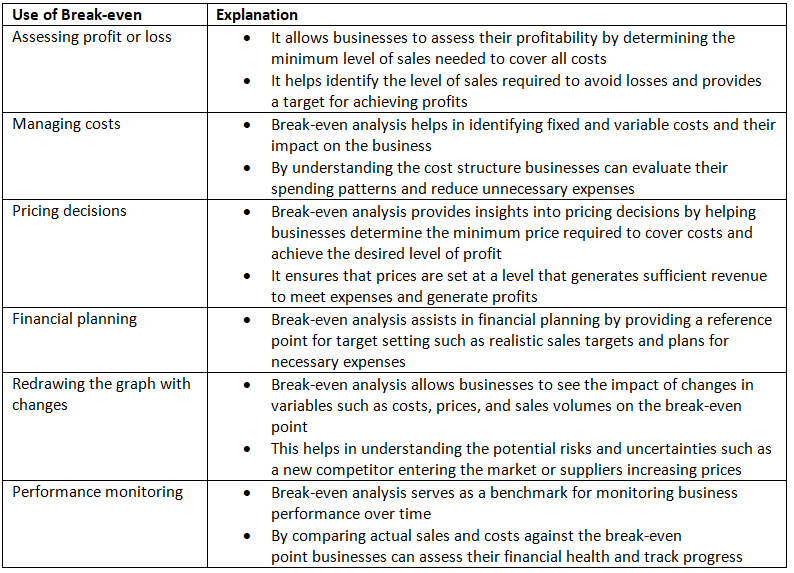Year 11 Exam > Year 11 Notes > Business Studies for GCSE/IGCSE > Break-even Calculations
Break-even Calculations | Business Studies for GCSE/IGCSE - Year 11 PDF Download
Calculating Break-even
- The break-even point can be determined using one of two methods:
- The first method calculates the number of units that must be sold to reach the break-even point.

- The second determines the point at which the company neither makes a profit nor incurs a loss.

The Margin of Safety
- The margin of safety represents the surplus of units sold beyond the break-even point.
- It offers valuable insights to a company regarding the number of sales it can decline before incurring a loss.
- The margin of safety can be computed with the formula:

- Companies aim for a sizable margin of safety to mitigate risks associated with fluctuating demand.
Question for Break-even CalculationsTry yourself: How is the break-even point calculated?View Solution
Using Break-even Analysis to Make Business Decisions
- Break-even analysis is a valuable tool for businesses when determining production levels and estimating profits.
- It plays a crucial role in communicating with stakeholders such as investors or lenders, influencing their decisions to invest in the business.
- Understanding when a business will break-even or the expected profit can significantly impact shareholder interest.
- Break-even analysis forms the foundation for well-informed decision-making processes within an organization.
- It aids businesses in evaluating costs and expected returns related to new projects and expansion strategies.
- By identifying the break-even point, businesses can evaluate risks and rewards associated with various decisions.
Examples of Using Break-even in Decision-making

The document Break-even Calculations | Business Studies for GCSE/IGCSE - Year 11 is a part of the Year 11 Course Business Studies for GCSE/IGCSE.
All you need of Year 11 at this link: Year 11
|
70 videos|94 docs|25 tests
|
FAQs on Break-even Calculations - Business Studies for GCSE/IGCSE - Year 11
| 1. What is the significance of calculating break-even for a business? |  |
Ans. Calculating break-even is important for a business as it helps determine the point at which total revenue equals total costs, indicating the level of sales needed to cover all expenses. This information can assist in setting pricing strategies, determining production levels, and making informed decisions about the financial health of the business.
| 2. How can break-even analysis be used to make business decisions? |  |
Ans. Break-even analysis can help businesses make decisions regarding pricing strategies, production levels, and cost management. By knowing the break-even point, businesses can set sales targets, assess the impact of changes in costs or prices, and evaluate the feasibility of new projects or investments.
| 3. What is the margin of safety and why is it important for businesses? |  |
Ans. The margin of safety is the difference between actual sales and the break-even point, indicating how much sales can drop before the business starts incurring losses. It is important for businesses as it provides a buffer against uncertainties and helps assess the risk of not meeting sales targets.
| 4. How can break-even calculations help in evaluating the financial performance of a business? |  |
Ans. Break-even calculations can help in evaluating the financial performance of a business by providing insights into the relationship between costs, sales, and profits. By comparing the break-even point with actual sales, businesses can assess their efficiency, profitability, and competitiveness in the market.
| 5. What are the key components involved in break-even calculations for a business? |  |
Ans. The key components involved in break-even calculations include fixed costs, variable costs, selling price per unit, and the break-even point. By analyzing these components, businesses can determine the minimum level of sales needed to cover all costs and start generating profits.
Related Searches



















